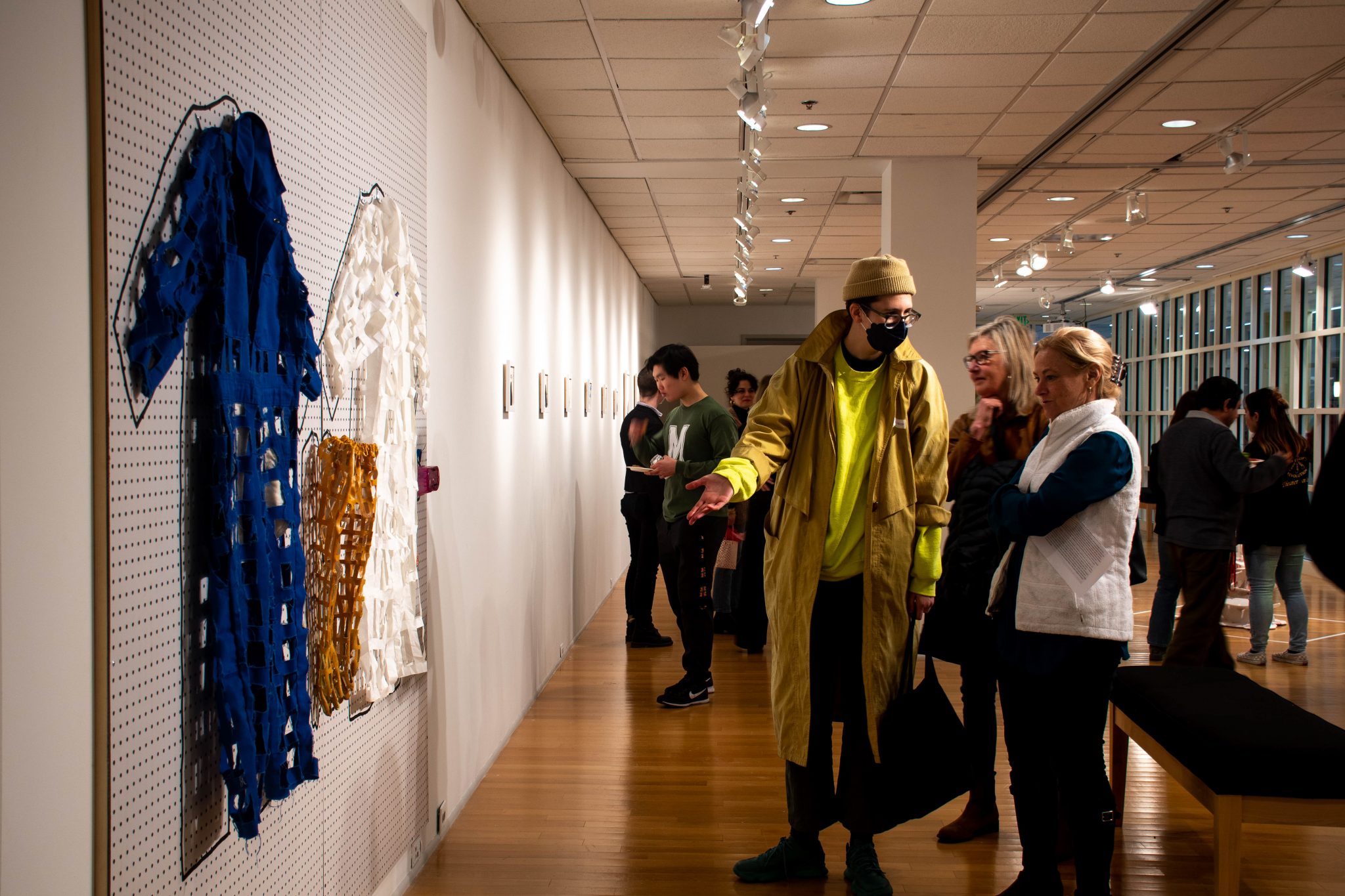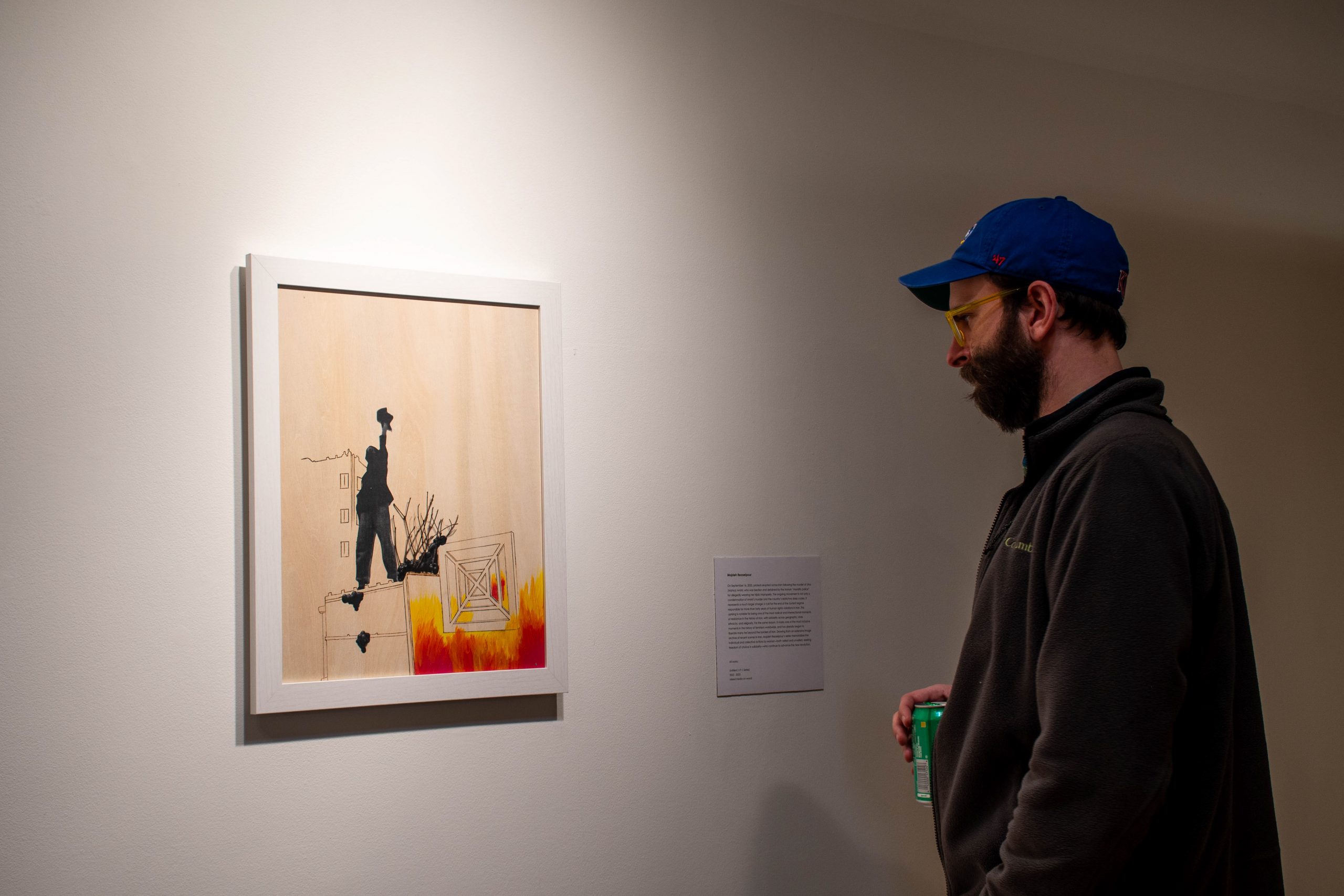“UNFOLD,” a new exhibit at the University of Maryland Stamp Student Union Gallery, explores people’s connection to clothing and textiles.
The show includes the work of four artists in the Washington metro area. The Stamp Gallery exhibits contemporary art from emerging to mid-career artists. The exhibit opened Jan. 30 and closes April 1.
Maura Callahan, an art history doctoral student, is the curator of “UNFOLD” and the graduate assistant for the gallery. As she began to piece the show together, Callahan said she viewed the collection as having four categories that describe different purposes or ways to frame clothing: gender, state, environment and labor.
[Eggs-traordinary prices: Here’s how egg shortages are affecting UMD]
“We usually think of clothing as primarily utilitarian or expressive of personal identity,” Callahan said. “There are many other dimensions of clothing and the way that it sort of operates in our lives and how we relate to each other as people, how we relate to our environments, to our political and social world.”
Here’s a look at the artists featured.
Elliot Doughtie
Elliot Doughtie’s work represents gender. His pieces use classic men’s socks, plastered to make them stiff, to represent the failure of fitting into gender norms. Doughtie grew up in Dallas, Texas, surrounded by “macho” culture — he didn’t feel like he fit in.
“I make these floppy objects hard and stacked on each other … because they defy what they are supposed to be in a way that’s supposed to be a metaphor for gender defying or the failure of prescribed gender,” Doughtie said.
Mojdeh Rezaeipour
Mojdeh Rezaeipour’s work represents how governments can control and define clothing. She is an Iranian-born artist whose pieces document the ongoing protests and uprising in Iran following the death of Mahsa Amini. Amini died after being arrested by Iran’s morality police for improperly wearing a hijab in September 2022.
Rezaeipour is working to make their studio act as an analog newsroom of images coming out of Iran.
“Some of my most formative experiences were colored with these systemic experiences of fascism and gender apartheid,” Rezaeipour said. “As people have been resisting the overt oppression of [the Iranian] government, it’s always really spoken to me.”
For “UNFOLD,” she painted images of women holding their hijabs off of their heads and existing during the ongoing revolution on wooden canvases.
“It’s so much bigger than clothing, it is not just about mandatory hijab,” Callahan said about the movement. “Now, it’s about taking down this government altogether.”
Hoesy Corona
Hoesy Corona’s work tackles the environment and immigration through his “climate ponchos.” The artist paints scenes of figures immigrating over nature scenes to describe how climate change is turning people into immigrants around the world.
In the U.S., there is a lot of xenophobia directed toward certain immigrant groups but not all immigrants, Corona explained. He wanted to implicate as many groups of people as possible in his work. Incorporating climate change elements was their way to accomplish this.
Corona’s work features people traversing across land, with either solid bright colored or camouflage-patterned bodies, carrying suitcases and other possessions.
“We don’t know who they are, we don’t know their identities, we don’t know their intentions,” Corona said, “That stuff visually hints at the ways in which we weaponize dehumanization, to hurt other people.”
[College Park elections board recommends permanent vote-by-mail list system]
He made his art on ponchos because they can represent protection from the harsh, changing climate. The ponchos were created for his upcoming performance art showcases.
H.H. Hiaasen
H.H. Hiaasen, whose work represents how clothes represent labor, cuts gridded holes into traditional protective gear to create an anti-uniform. The garments used include coveralls, gloves and eye masks.
When Hiaasen moved to New York, they experienced a culture shock of the city’s grind culture.
“The first thing they ask is, ‘what do you do?’” Hiassen said. “It’s just a city that is constantly working … it just feels like you’re part of a huge mass production kind of grind culture all the time.”
Hiaasen said they felt they had no emotional connection to what they were doing. They then had the idea to cut the gridded holes into coveralls and began wearing them to work. Now, Hiaasen sells the garments — this gallery is the first time their garments have been displayed in many years.
The clothing also represents a “queer uniform” to Hiaasen.
“To me, the cut suit, like making mesh out of a work item … feels very queer, inherently,” Hiaasen said.
The gallery is free and open to the public on the first floor of Stamp Student Union.





